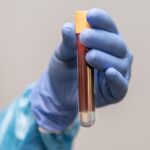Study suggests a vaccine-like active immunotherapy treatment could allow for a novel migraine treatment that is both more convenient and affordable than current commercial medications.
The Problem
Migraines are the second most frequent cause of disability in the world, impairing individuals during the most productive periods of their lives. Like many neurological conditions, migraines remain a puzzle scientists are trying to solve, often making treatment identification very difficult.
Despite this, calcitonin gene-related peptide (CGRP), which normally helps control blood pressure by triggering vasodilation, has long been known to play a central role in migraine attacks and neurogenic inflammation when present in excess. As such, CGRP and its receptors are often targeted by migraine treatments.
There are many ways to target CGRP and its effects. Treatments include small-molecule drugs (gepants) which block the receptor or monoclonal antibodies (mAbs) that either block the receptor or bind directly to CGRP, preventing it from interacting with its receptors and causing trouble. While mAbs work well, they’re expensive, require frequent injections, and aren’t easily accessible worldwide. This has led researchers to ask if the body could be ‘trained’ to generate its own defense against CGRP.
Proposed Solution and Testing
To explore this idea, researchers designed a peptide-based ‘vaccine’ that triggers the immune system to produce antibodies that can recognize and neutralize CGRP. The key immunogen, which is the molecule responsible for inducing the immune response, called p4796kb, is combined with the CGRP epitope—the tail end of the molecule responsible for receptor binding—using a helper peptide, which allows immune cells to recognize it more effectively. This design aimed to stimulate the body to make anti-CGRP antibodies; the same type of molecule that commercial mAbs drugs provide, but made naturally by the body.
To test if this peptide was immunogenic, the researchers immunized rats, guinea pigs, and non-human primates and measured antibody levels using a technique called Enzyme Linked Immunosorbed Assay (ELISA). Just a few weeks after immunization with p4796kb, the animals developed strong anti-CGRP antibodies, confirming that the peptide successfully triggered an immune response across different species, most notably, in monkeys whose CGRP is 100% similar to humans. Further testing also indicated that the production of type IgG1 was induced, which is known for stability and long lasting protection, compared to other antibody types such as IgM, which are typically responsible for short-term inflammation. These results, although highly promising, raise potential safety concerns such as the risk of an induced inflammatory immune response against the CGRP that the body produces (endogenous CGRP) or other proteins.
To verify that the immune response was both safe and specific, the researchers collected serum samples prior to immunization. Six hours after each dose the levels of 9 inflammatory cytokines were measured in the rat serum. These tests revealed no significant increase in inflammatory cytokines, suggesting that the ‘vaccine’ did not cause any unwanted immune activation. The researchers then isolated immune cells (splenocytes) and confirmed that they only reacted to the immunization’s peptide components, not the endogenous CGRP produced by the body. These findings rule out autoimmune side effects that may result from the body mistaking its endogenous proteins for a pathogen. Additionally, molecular mapping and arrays of thousands of human proteins were tested using a HuProt Human Proteome Microarray screen of antibody binding revealed that the antibodies targeted the effective region of CGRP without significantly binding to any other proteins, confirming that the antibody response was focused exactly where it needed to be.
Having confirmed that the antibodies produced can be safely generated by the body and bind to the most important part of the CGRP molecule, the team investigated whether the antibodies could actually block CGRP’s biological effects and how it compared to current mAb treatments. The binding potency of purified antibodies from immunized guinea pigs were compared to that of commercial therapeutic mAbs. This experiment demonstrated that the produced antibodies bound to human CGRP with affinity in the same range as the therapeutic mAbs. Additionally, the researchers utilized a rat model to test the in-vivo effect of the produced antibodies. This was done by exposing the rats to capsaicin, which is the same molecule that gives spicy foods their signature burn and is also known to increase blood flow through CGRP release. Normally this would cause strong blood vessel dilation, however, immunized rats showed significantly reduced dermal blood flow compared to the controls following exposure to capsaicin, demonstrating that the antibodies were successfully neutralizing the CGRP in the body. This effect was comparable to that of Galcanezumab, an approved monoclonal antibody therapy, highlighting that the endogenously produced anti-CGRP antibodies of active immunotherapy could perform just as well as current monoclonal treatment.
Together, these findings demonstrated that an active immunotherapy targeting CGRP can safely induce long-lasting functional antibodies that are capable of neutralizing migraine-related signalling in a similar potency to current mAb based treatments. However, what does this mean for the future?
From Monthly Injections to Lasting Immunity
It is undeniable that the results of this preclinical study are extraordinarily promising. In both in-vitro and animal models, this active immunotherapy treatment appears to offer all of the upsides of monoclonal antibody migraine treatments without their typical downsides. Unlike mAbs, which require monthly high-dose injections due to their short half-life and are costly to produce, peptide based immunogens are simpler, scalable, and far more affordable because the antibodies are made by the body itself. Even more, this approach could offer longer lasting protection with boosters only needed quarterly or biannually as opposed to monthly. Excitingly, this treatment is now advancing to clinical trials, highlighting its remarkable potential to make migraine prevention not only more convenient and affordable, but considerably more accessible on a global scale.
References
- Boyd, J. D., Wang, S., Lin, H.-W., Hsieh, Y.-T., Sun, Y. S., Thibodeaux, B. A., Lu, H., Sahni, J., Wiggins, J., Longo, M. S., Brooks, J. K., Vroom, M. M., Chang, Y.-P., Liu, Z., Ding, S., & Dodart, J.-C. (2025). Preclinical characterization of an active immunotherapy targeting calcitonin gene-related peptide. Communications Medicine, 5, 145. https://doi.org/10.1038/s43856-025-00870-2
- How Do CGRP Inhibitors Work? (n.d.). Cleveland Clinic. Retrieved October 18, 2025, from https://my.clevelandclinic.org/health/treatments/cgrp-inhibitors
- IgG vs IgM: Difference, When They’re Ordered & Results. (2024, July 2). Tua Saúde. https://www.tuasaude.com/en/igg-vs-igm/
- U_if8o5n0ioo (n.d.). Man Woman Migraine—Free photo on Pixabay. (n.d.). Retrieved October 18, 2025, from https://pixabay.com/photos/man-woman-migraine-healthcare-8225398/
- Rashid, A., & Manghi, A. (2025). Calcitonin Gene-Related Peptide Receptor. In StatPearls. StatPearls Publishing. http://www.ncbi.nlm.nih.gov/books/NBK560648/








